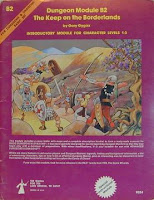This is a sequel post to the
Random Colony Generator from way back in 2012.
[A] [B] [C], troubled by [D].
A — condition
1: sleek and brand-new
2: well-maintained
3: beat-up and rugged but functional
4: ramshackle
5: broken (roll twice on Trouble table)
6: fragmented (roll 1d6 for number of pieces, roll on the trouble table for each section)
B — Size
1: Up to 20m (Examples: Soyuz capsule, Huey helicopter, Spacelab)
2: 20m to 50m (Examples: C-130 Hercules, Space shuttle orbiter)
3: 50m to 100m (Examples: C-5 Galaxy, Boeing 747, Antonov AN-225 Mriya)
4: 100m to 200m (Examples: International Space Station)
5: 200m to 500m (Examples:
Nimitz-class aircraft carrier)
6: 500m or more (Examples: Burj Khalifa hotel)
C — Type
1: Space Survey (Examples: astronomical surveyor, space anomaly investigation, navy scout ship)
2: Planetary Survey (Examples: terraforming surveyor, prospector, biological surveyor, xenoarchaeological excavation, army scout ship)
3: Passenger transport (Examples: liner, colony ship, refugee transport, snakehead smuggling ship)
4: Freighter (Examples: courier, free trader, bulk freighter)
5: Military (Examples: patrol ship, search-and-rescue vessel, weapons platform, drone carrier, assault craft)
6: Station (Examples: refueling station, trading post, communications relay, defensive outpost, navigational buoy, sensor array, orbital habitat)
D — Trouble
1: Lack of resources. (Examples: leak in fuel, fuel made useless through radiation or contamination, trapped in an area where solar power or other resource cannot be gathered)
2: Control system failure. (Examples: computer malfunction, navigational malfunction, remote-operation input malfunction)
3: Power failure. (Examples: power generator failure, engine failure)
4: Life-support failure. (Examples: cryotubes killing crew, cryotubes not opening on time, atmospheric integrity loss, failure of quarantine procedures)
5: Primary mission system failure. (Examples: weapon system failures on a military ship, sensor system failures on a deep space probe, cargo containment failures on a freighter)
6: “Nothing.” (Or, roll again for incipient failure, or roll on the Black Stars Hang trouble chart)








